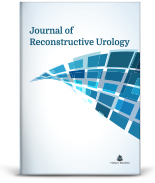Objective: The coronavirus disease-2019 (COVID-19) outbreak is the latest and greatest disease affecting all over the world recently. Despite the measures being taken in countries, data related to the COVID-19 outbreak is increasing day by day. The diagnosis of COVID-19 patients with atypical/non-specific symptoms is likely to be overlooked during this pandemic process. This study aimed to investigate the changes in lower urinary tract symptoms (LUTS) in females after COVID-19 infection. Material and Methods: A total of 62 female patients who were diagnosed with COVID-19 were included in the present study. The International Consultation on Incontinence Questionnaire-Female Lower Urinary Tract Symptoms (ICIQ-FLUTS) scores of patients measured before and during COVID-19 infection were compared. Furthermore, the ICIQ-FLUTS scores after COVID-19 infection were compared with thoracic computed tomography findings. Urinary tract infections and other causes affecting urinary frequency were excluded from the study. Results: Total ICIQ-FLUTS scores after COVID-19 infection were found statistically increased in female patients (p<0.0001). However, increased LUTS were not correlate with violence of lung involvement (r=0.063, p=0.629). Conclusion: Information about COVID-19 is limited since it is a quite new disease. The LUTS were found to significantly increase in female patients after COVID-19 infection, regardless of the severity of the disease.
Keywords: COVID-19; female; lower urinary tract symptoms
Amaç: Koronavirüs hastalığı-2019 [coronavirus disease-2019 (COVID-19)], salgını son zamanlarda tüm dünyayı etkileyen en son ve en büyük hastalıktır. Alınan önlemlere rağmen COVID-19 salgınına ilişkin veriler her geçen gün artmaktadır. Atipik/spesifik olmayan semptomları olan COVID-19 hastalarının teşhisi, bu pandemi sürecinde muhtemelen gözden kaçmaktadır. Bu çalışma, kadınlarda COVID-19 enfeksiyonu sonrası alt üriner sistem semptomlarındaki (AÜSS) değişiklikleri araştırmayı amaçlamıştır. Gereç ve Yöntemler: Bu çalışmaya, COVID-19 tanısı konan toplam 62 kadın hasta dâhil edildi. Hastaların COVID-19 enfeksiyonu öncesi ve enfeksiyon sırasında ölçülen Kadın Alt Üriner Sistem Semptomları -Uluslararası İnkontinans Anketi [The International Consultation on Incontinence Questionnaire- Female Lower Urinary Tract Symptoms (ICIQ-FLUTS)] puanları karşılaştırıldı. Ayrıca COVID-19 enfeksiyonu sonrasındaki ICIQ-FLUTS skorları, toraks bilgisayarlı tomografi bulguları ile karşılaştırıldı. İdrar yolu enfeksiyonu ve idrar sıklığını etkileyen diğer nedenler, çalışma dışı bırakıldı. Bulgular: Kadın hastalarda COVID-19 enfeksiyonu sonrası toplam ICIQ-FLUTS skorları istatistiksel olarak artmış bulundu (p<0,0001). Ancak bu artmış AÜSS akciğer tutulum şiddeti ile ilişkili değildir (r=0,063; p=0,629). Sonuç: COVID-19, oldukça yeni bir hastalık olduğu için hakkındaki bilgiler sınırlıdır. AÜSS'nin, hastalığın şiddeti ne olursa olsun, COVID-19 enfeksiyonundan sonra kadın hastalarda önemli ölçüde arttığı bulundu.
Anahtar Kelimeler: COVID-19; kadın; alt üriner sistem semptomları
- Naspro R, Da Pozzo LF. Urology in the time of corona. Nat Rev Urol. 2020;17(5):251-3. [Crossref] [PubMed] [PMC]
- World Health Organization [Internet]. © 2021 WHO. Coronavirus disease 2019 (COVID-19) Situation Report-51, 11 March 2020. (Erişim tarihi: 11 Mart 2020) Available from: [Link]
- World Health Organization [Internet]. © 2021 WHO. Coronavirus disease 2019 (COVID-19) Situation Report-198, 5 August 2020.(Erişim tarihi: 5 Ağustos 2020) Available from: [Link]
- Wang D, Hu B, Hu C, Zhu F, Liu X, Zhang J, et al. Clinical characteristics of 138 hospitalized patients with 2019 novel coronavirus-infected pneumonia in Wuhan, China. JAMA. 2020;323(11):1061-9. Erratum in: JAMA. 2021;325(11):1113. [Crossref] [PubMed] [PMC]
- Mumm JN, Osterman A, Ruzicka M, Stihl C, Vilsmaier T, Munker D, et al. Urinary frequency as a possibly overlooked symptom in COVID-19 patients: does SARS-CoV-2 cause viral cystitis? Eur Urol. 2020;78(4):624-8. [Crossref] [PubMed] [PMC]
- Prokop M, van Everdingen W, van Rees Vellinga T, Quarles van Ufford H, Stöger L, Beenen L, et al; COVID-19 Standardized Reporting Working Group of the Dutch Radiological Society. CO-RADS: A categorical CT assessment scheme for patients suspected of having COVID-19-definition and evaluation. Radiology. 2020;296(2):E97-104. [Crossref] [PubMed] [PMC]
- Wang C, Horby PW, Hayden FG, Gao GF. A novel coronavirus outbreak of global health concern. Lancet. 2020;395(10223):470-3. Erratum in: Lancet. 2020. [Crossref] [PubMed] [PMC]
- Wang W, Xu Y, Gao R, Lu R, Han K, Wu G, et al. Detection of SARS-CoV-2 in different types of clinical specimens. JAMA. 2020;323(18):1843-4. [Crossref] [PubMed] [PMC]
- Ling Y, Xu SB, Lin YX, Tian D, Zhu ZQ, Dai FH, et al. Persistence and clearance of viral RNA in 2019 novel coronavirus disease rehabilitation patients. Chin Med J (Engl). 2020;133(9):1039-43. [Crossref] [PubMed] [PMC]
- Kim YI, Kim SG, Kim SM, Kim EH, Park SJ, Yu KM, et al. Infection and rapid transmission of SARS-CoV-2 in ferrets. Cell Host Microbe. 2020;27(5):704-9.e2. [Crossref] [PubMed] [PMC]
- Zou X, Chen K, Zou J, Han P, Hao J, Han Z. Single-cell RNA-seq data analysis on the receptor ACE2 expression reveals the potential risk of different human organs vulnerable to 2019-nCoV infection. Front Med. 2020;14(2):185-92. [Crossref] [PubMed] [PMC]
- Varga Z, Flammer AJ, Steiger P, Haberecker M, Andermatt R, Zinkernagel AS, et al. Endothelial cell infection and endotheliitis in COVID-19. Lancet. 2020;395(10234):1417-8. [Crossref] [PubMed] [PMC]
- Ge H, Wang X, Yuan X, Xiao G, Wang C, Deng T, et al. The epidemiology and clinical information about COVID-19. Eur J Clin Microbiol Infect Dis. 2020;39(6):1011-9. [Crossref] [PubMed] [PMC]







.: Process List